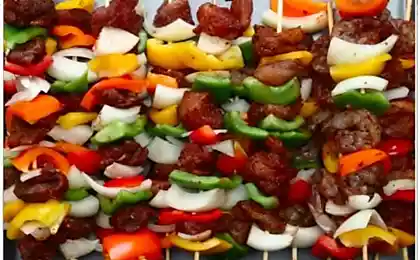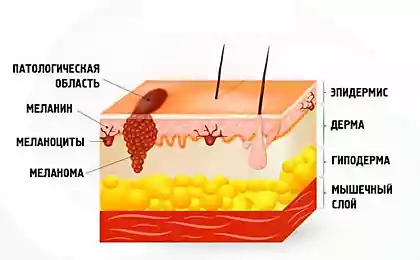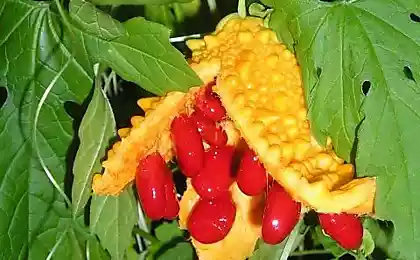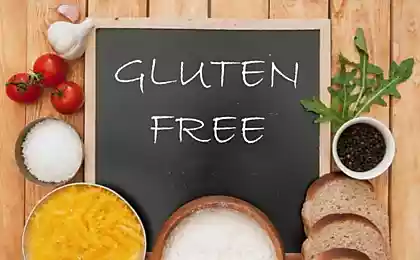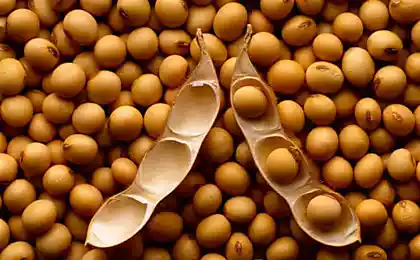822
Protein Diggers or which produces a protein biochemists
source
35 photos + letter
All of us went to school, and, among other things, have textbooks on biology and chemistry. Some of them probably once read. Sometimes we hear in the news that British scientists have made another breakthrough, and sometimes even shlopotat Nobel Prize for his discovery. And someone might imagine a smart gray-haired man in glasses, who all his life a lot of thought, was a genius and one day it dawned idea. Well, I will tell you so, in reality, all these discoveries is rarely one person. Usually there is a head of the laboratory (and later give it to him in the event that the Nobel and runs a team of scientists, graduate students, undergraduates and students easy. It's hard to imagine how much work is actually invested in the a single line textbook of biology or chemistry. Graduate students tried dozens of combinations to find out exactly how the proceeds kind of reaction or process invented methods how to better and more precisely measure the result. One experiment can last from several hours to several years (depending on the subject research). On one line in the book sometimes took years man-labor.
So, I am a graduate student, a biochemist, I am 29 years old and I love it when they call me Lu. I live the life of a scientist, experimenter, and to me this life is very much like life magicians from some book-fantasy. All day (on weekends too often) we are sitting in their towers magic level ten laboratories that reason, in many cities around the world are carried out of the city, not an eyesore to ordinary citizens, apparently. I even have an official address in Germany was "such and such a street, tower number four." At the moment I'm working in France, in Strasbourg. We work with all sorts of instruments, the purpose of which in any way can not be guessed by their appearance, and read strange letters that are beyond the power of mere mortals, and dedicated to have to learn a lot of years to understand them some hell. [Next]
I want to show a normal weekday usual post-graduate (Thursday 21.07.11 - although weekday, weekend, what's the difference ...) and told in detail on what and why we are working because I enjoy it. Since I very interesting to read about what people are doing other jobs, I thought someone might be interested to know about biochemistry. In addition, all of a sudden some doubter student sees this post and decide whether or not to send him to his foot in graduate school (this thing is very amateur). I also genuinely curious if I can explain to the layman are the most basic methods used in biochemistry. So fasting is a lot of tubes, strange devices, appliances, cans, capillaries. And a lot of explanations and technical details.

I belong to the greater part of humanity, which the owls. All the years of his life spent in school, university, work, master never forced me to get used to waking up in the morning with a hearty and quickly develop intense activity. Among scientists cos in general for some reason very much, and they certainly quickly invented scientific proof that you are a night owl or an early bird, due to the peculiarities of your metabolism. In general, referring to this evidence, I peacefully wakes up three alarm clocks (at 8:15, 8:45 and 9:00), triggered alarm is not biological. Biology I set somewhere in the 9:40 - 9:50. 10 minutes after prodiraniya eyes I still toss and turn in bed painfully and zyryu window. Outside the window, if you're lucky, the clouds give

In the end I still get up, because the teleport, scientists have not yet invented. Due to the fact that I really love to sleep, I have developed a habit of evolutionarily very quickly to assemble in the morning. I quickly wash, get dressed, grab a bag (at all about everything goes exactly 10 minutes) do not eat breakfast and "to work, to work on his favorite work !!!". Run to work on foot 10 minutes, too. Won our NIICHAVO is seen in the bushes.

...

Hello, workplace!
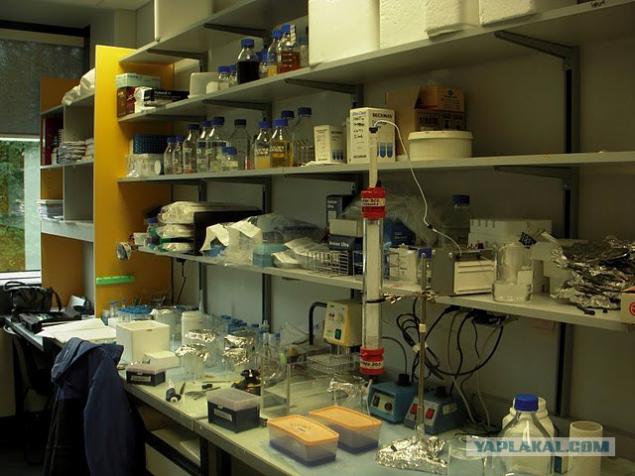
...
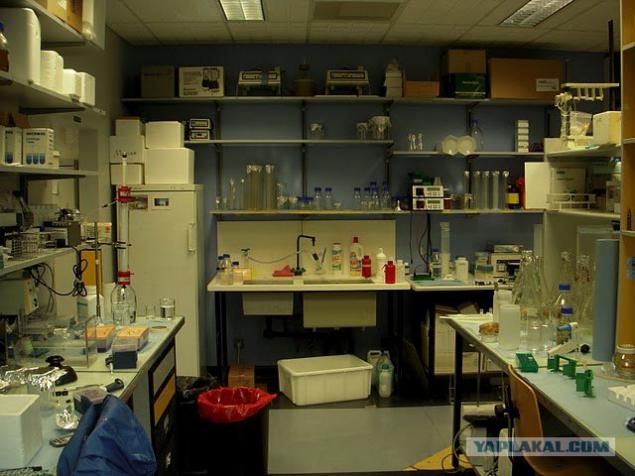
Get up, I got up, but because my mind was still morning, I am functioning on autopilot. It is necessary to drink coffee (which I have almost no effect) and eat something sweet, then let go. Eating and drinking in the laboratory, of course, impossible, and can be in specially designated areas

After coffee, I'm still a little esteem the Internet, my head cleared up, I bent arms nitrile gloves and shoots develop rough activity. We work, of course, all the while wearing gloves, firstly, to not get your hands on everything that should not be, and secondly, not to bring some dirt in super-clean designs.

The artist works with a brush, a pianist plays piano, I did the whole day here waving a pipette. Such pipettes are gaining small amounts of liquids - anything less than one milliliter up to 1 microliter. One microliter - it's such a malyuyuyuyuyuyusenkaya droplet. In comparison, if you drip all known glass pipette, for example, eye drops - in such a drop is about 200 microliters. The pipette has a removable disposable tip, which you can see on the pictures to each new recruit clean fluid tip.

And now a few words about what it is we're going to do today. For the story, I chose the most typical day. Most postgraduate biochemists around the world are engaged in a rather monotonous activity, namely purified proteins (= "proteins"), and give them a variety of tests. Protein - is the generic name for a vast class of biological molecules. Why graduate students all over the world so much protein, you ask? The fact that in the living cell proteins perform many of the most diverse functions. Imagine, say, a car factory. If the entire plant - a living cell, almost everything in it is inside - all machines, conveyors, work, and the cars themselves - it will be proteins. Scientists, first, learn what exactly is the function performs a particular protein in a cell. Secondly, the proteins with known functions can be used as a tool for further research. If we want to use any protein, then where do we get it? Of course, in the living cell! Because it is at this factory produce them in large quantities! To do this, the most commonly used bacterial cells, because they are very easy and inexpensive to maintain and grow quickly. Methods of modern genetic engineering allow you to program the cell so that it produces more of the protein necessary to us. And then we'll get him out of there and clean. And we will use in the experiments.
Bacterial cells are grown in a liquid nutrient medium. For example, here in such flasks (flask 5 L of liquid therein 1L) located in a room where the temperature is kept 37 ° C (or in the oven incubator). The flasks were mounted on a special platform, which continuously rotates and agitates the contents, wherein the culture medium is enriched with oxygen, and from this bacteria grow best. Photo from the "yesterday", but then cool to see where the bacteria live in the laboratory. Overnight we have grown bacteria to the desired stage, then precipitated bacterial cells from liquid (stuck to the centrifuge and spun at 6000 rpm, the bacterial cells - "heavy" and therefore settled in the bottom of the crockery by centrifugal force), dig them from the bottom of crockery spatula and immediately frozen in liquid nitrogen (temperature -196 ° C). Instant freezing is important to cells and their contents have not started to collapse from such brazen treatment (as we remember that we want to extract the precious protein that cell bioreactors, we have built up).

So, at 11:08 hours, and I'm running gloves in the freezer of frozen on the eve of the sample. Frozen cells and other valuable samples stored in a freezer at -80 ° C. I open the freezer and the first thing out of it brings down the thick steam.

Quickly, so as not to freeze your fingers in gloves, grabs I cooked the evening cells. They are wrapped in foil and I crush them like a chocolate bar, on smaller pieces until melted. As they thaw, a ball of cells will be similar to a piece of brown-gray clay with a very distinctive smell. The bacterium, which is the standard used to work in a laboratory, called E. coli (Escherichia coli, or, in abbreviated form, E. coli). This is the same E. coli, which several killogrammov lives in the intestines of each of us. Being outside the body, it is, although it has a very distinctive smell, but the smell still does not waste life. However, I'm afraid people are unaccustomed, connoisseurs with a fine sense of smell, we would not call this a pleasant smell.

On the way to the freezer at one naberёm ice box - will keep the samples on ice, because at low temperatures, all compounds is much more stable.

Melted bacterial cells we put in a test tube and Fill the special salt solution. A solution is needed to ensure that protein, which we are trying to extract from the cells remained intact during all cleaning procedures. In the photo the other pipette more on volumes up to 30 mL.

So we have cells that float in the solution. Inside the cells have coveted our component (protein). To get it, you need to start to destroy the cell membrane, the contents spilled out. There are various ways to destroy the cell, leaving intact its contents. Today we will use for this purpose ultrasound. And this is how the device looks for the destruction of cells - in fact, it is a metal pin, which we poke right in the test tube. Pin oscillates a very high frequency, creating an ultrasonic wave in the medium - the cells from being destroyed. The device is thus very nasty vereschit and grinds, so it locked in a safe soundproofed. A tube of cells must be kept in the ice, because the ultrasonic waves have high energy, and the sample is heated very much.

Procedure destruction takes about 20 minutes. In this photo you can see that by the destruction of the cell sample was lighter, after the destruction of the darkened and became more viscous (viscosity is not visible, of course, but I'm telling you). Viscosity is acquired due to the fact that all biopolymers (very long molecules like DNA and proteins) that were inside the cells now flowed out.

We now have in vitro formed a kind of "soup" in which anything can swim! All the components that were in cells, and their thousands flowed outwardly and mixed. Imagine that you have a good nourishing soup, and you miraculously have to extract from it only tiny pieces of parsley, and that nothing in any case not fall! How? Well, I do not know about the soup, how to extract the desired molecule, biochemists have long been invented. We spend several purification steps. First of all we poke our "soup" in a centrifuge and unwind with a relatively low speed (10,000 rev / min). At this speed, it will settle to the bottom of the large particles, such as fragments of bacterial cell walls, and all the smaller particles, including our protein remain floating in the solution. It looks like a test tube with sediment - his throw us, but we will take the liquid for further purification. Please note what it is that dark. Stage took 15 minutes.

In the next step we get rid of nucleic acids (the famous DNA and RNA), which also swim in the sample in large quantities. We will add a special reagent that zastvlyaet drop them into the sediment. In the photo - the sample before (left) and after (right) adding a reagent.

This case, too, we shove into a centrifuge, and also twist the 10,000 rev / min, and all that go away in a deposit, throw again and again zaberёm liquid itself. Notice how she brightened. It took about 20 minutes.

Now another similar stage cleaning - monotonous but effective. Last boring step further fun mound We strictly certain amount of white powder (ammonium sulfate salts) in solution. A little trick - thus precipitated a lot of different proteins that we do not need, and our precious will swim in solution! Some other graduate student many years ago he tortured and picked the exact amount of white powder, which is necessary for it to take, as I now use the experience of generations, so to speak. But that only means that I suffer over something else.

What next with the sample - we already know, in the scheme established to twist it in a centrifuge, zaberёm fluid, fast forward it to the net and cup and let stand in the refrigerator, because we have a lunch break! And therefore, the clock already 13:00.
Before dining stomp minutes 5. The French dining room deserves a lyrical digression! This is the best room of all I've seen, though, they say, is not the best in Strasbourg. The French, of course, not stupid to eat. In what other dining room you will find a dozen salads alone, not to mention the main dishes. Meals for my taste, with delights - prawns with grapefruit, Roquefort cheese with arugula, chicken with pineapple and crackers and anything else. Besides, salads do not just flop down in a plate of a large basin, as do, for example, in Germany, and on each platter salad decomposed art - aesthetic minimized ham, put a slice of lemon / egg / olivochka and even sauce sometimes poured ornate monogram. And most importantly, delicious! In general, salads fascinated me, so I eat most of them, and even before the main courses do not reach, but there, too, all the artistic and delicious. Once issued some shellfish cooked in a large shell with cheese sauce. In Germany, I have seen a lot of different dining rooms, all of them were fed to satiety, in some - tasty, but has never been brought into food as aestheticism. For lunch, we walk more often with two cheerful colleagues.

However, 13:50, and it is time again for the job. Get on a minute, we coat and went to the North Pole for almost here this door. About the coat is not a joke - we will continue to work in a room where the temperature is maintained at all times + 4 ° C. It's cold, damn it.

And behind the door, then the door !!! There is such! Behind the door is, among other things, that such a unit.

For device I hello everyone.
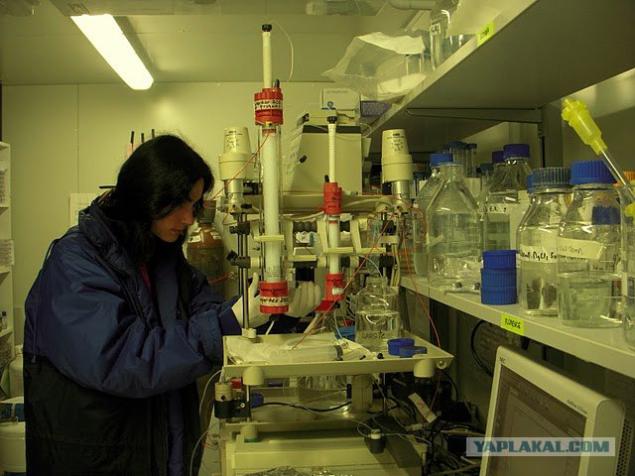
I confess that when I first saw this device, as a student, I almost ran away in fear. It seemed to me that to understand there is absolutely nothing is impossible, and it is comparable in complexity to the submarine. Around there are some cans, cones, sticks out from the unit a bunch of capillaries, each in its solution, and cling to the instrument are disengaged additional details, of which there is present in a variety and diversity. In general, features a leg break.
In fact, everything was much easier. The device is called the chromatograph. It is used when there is a mixture of components neskolkiz and must be separated from one another in some way. Chromatographs are of different types, it is this - liquid chromatography. One of its components is a pump that can pump the liquid (ie our sample) from point A to point B. Along the way, the sample will pass through a special "purification plant" that will allow us to get rid of unwanted impurities. Separating column in the range:

So, before the break, but the dinner we had left in the fridge is half purified mixture of proteins. However, should remain only one! Stick-ka mixture into the chromatograph and see what happens. Naberёm our sample into the syringe and gently introduce into the inner chamber chromatograph.

Then click next to the "Start" button and we nervously smoking in the corner to look forward to results!
How different molecules separate from each other? There are various ways. Each protein is unique, has a certain size, charge and surface properties. It is these qualities and will be used to separate the mixture. Most often used sequentially several purification steps, for example, first size, then in charge.
Recall Cinderella. Once she was given a bag of different cereals and ordered away from there just one thing. If Cinderella had a technical mind, she came up with to use for this mesh. And even better several sieves in series with the cells of different sizes. So, first, it would be possible to select only the smallest, such as millet, then something more, such as lentils, and then still more, such as peas, beans. To separate the protein biochemists invented the so-called "molecular sieve" - a material having pores of a very, very small. More trick molecular sieve and that it is three-dimensional. The hollow cylinder is filled with microscopic beads, beads and through holes. The system works like this: the large molecules do not intermeddle in the holes in the beads so quickly fail down between the beads, nothing holds them.
That's all I wanted to say. Thank you all for your attention
Source:
35 photos + letter
All of us went to school, and, among other things, have textbooks on biology and chemistry. Some of them probably once read. Sometimes we hear in the news that British scientists have made another breakthrough, and sometimes even shlopotat Nobel Prize for his discovery. And someone might imagine a smart gray-haired man in glasses, who all his life a lot of thought, was a genius and one day it dawned idea. Well, I will tell you so, in reality, all these discoveries is rarely one person. Usually there is a head of the laboratory (and later give it to him in the event that the Nobel and runs a team of scientists, graduate students, undergraduates and students easy. It's hard to imagine how much work is actually invested in the a single line textbook of biology or chemistry. Graduate students tried dozens of combinations to find out exactly how the proceeds kind of reaction or process invented methods how to better and more precisely measure the result. One experiment can last from several hours to several years (depending on the subject research). On one line in the book sometimes took years man-labor.
So, I am a graduate student, a biochemist, I am 29 years old and I love it when they call me Lu. I live the life of a scientist, experimenter, and to me this life is very much like life magicians from some book-fantasy. All day (on weekends too often) we are sitting in their towers magic level ten laboratories that reason, in many cities around the world are carried out of the city, not an eyesore to ordinary citizens, apparently. I even have an official address in Germany was "such and such a street, tower number four." At the moment I'm working in France, in Strasbourg. We work with all sorts of instruments, the purpose of which in any way can not be guessed by their appearance, and read strange letters that are beyond the power of mere mortals, and dedicated to have to learn a lot of years to understand them some hell. [Next]
I want to show a normal weekday usual post-graduate (Thursday 21.07.11 - although weekday, weekend, what's the difference ...) and told in detail on what and why we are working because I enjoy it. Since I very interesting to read about what people are doing other jobs, I thought someone might be interested to know about biochemistry. In addition, all of a sudden some doubter student sees this post and decide whether or not to send him to his foot in graduate school (this thing is very amateur). I also genuinely curious if I can explain to the layman are the most basic methods used in biochemistry. So fasting is a lot of tubes, strange devices, appliances, cans, capillaries. And a lot of explanations and technical details.

I belong to the greater part of humanity, which the owls. All the years of his life spent in school, university, work, master never forced me to get used to waking up in the morning with a hearty and quickly develop intense activity. Among scientists cos in general for some reason very much, and they certainly quickly invented scientific proof that you are a night owl or an early bird, due to the peculiarities of your metabolism. In general, referring to this evidence, I peacefully wakes up three alarm clocks (at 8:15, 8:45 and 9:00), triggered alarm is not biological. Biology I set somewhere in the 9:40 - 9:50. 10 minutes after prodiraniya eyes I still toss and turn in bed painfully and zyryu window. Outside the window, if you're lucky, the clouds give

In the end I still get up, because the teleport, scientists have not yet invented. Due to the fact that I really love to sleep, I have developed a habit of evolutionarily very quickly to assemble in the morning. I quickly wash, get dressed, grab a bag (at all about everything goes exactly 10 minutes) do not eat breakfast and "to work, to work on his favorite work !!!". Run to work on foot 10 minutes, too. Won our NIICHAVO is seen in the bushes.

...

Hello, workplace!

...

Get up, I got up, but because my mind was still morning, I am functioning on autopilot. It is necessary to drink coffee (which I have almost no effect) and eat something sweet, then let go. Eating and drinking in the laboratory, of course, impossible, and can be in specially designated areas

After coffee, I'm still a little esteem the Internet, my head cleared up, I bent arms nitrile gloves and shoots develop rough activity. We work, of course, all the while wearing gloves, firstly, to not get your hands on everything that should not be, and secondly, not to bring some dirt in super-clean designs.

The artist works with a brush, a pianist plays piano, I did the whole day here waving a pipette. Such pipettes are gaining small amounts of liquids - anything less than one milliliter up to 1 microliter. One microliter - it's such a malyuyuyuyuyuyusenkaya droplet. In comparison, if you drip all known glass pipette, for example, eye drops - in such a drop is about 200 microliters. The pipette has a removable disposable tip, which you can see on the pictures to each new recruit clean fluid tip.

And now a few words about what it is we're going to do today. For the story, I chose the most typical day. Most postgraduate biochemists around the world are engaged in a rather monotonous activity, namely purified proteins (= "proteins"), and give them a variety of tests. Protein - is the generic name for a vast class of biological molecules. Why graduate students all over the world so much protein, you ask? The fact that in the living cell proteins perform many of the most diverse functions. Imagine, say, a car factory. If the entire plant - a living cell, almost everything in it is inside - all machines, conveyors, work, and the cars themselves - it will be proteins. Scientists, first, learn what exactly is the function performs a particular protein in a cell. Secondly, the proteins with known functions can be used as a tool for further research. If we want to use any protein, then where do we get it? Of course, in the living cell! Because it is at this factory produce them in large quantities! To do this, the most commonly used bacterial cells, because they are very easy and inexpensive to maintain and grow quickly. Methods of modern genetic engineering allow you to program the cell so that it produces more of the protein necessary to us. And then we'll get him out of there and clean. And we will use in the experiments.
Bacterial cells are grown in a liquid nutrient medium. For example, here in such flasks (flask 5 L of liquid therein 1L) located in a room where the temperature is kept 37 ° C (or in the oven incubator). The flasks were mounted on a special platform, which continuously rotates and agitates the contents, wherein the culture medium is enriched with oxygen, and from this bacteria grow best. Photo from the "yesterday", but then cool to see where the bacteria live in the laboratory. Overnight we have grown bacteria to the desired stage, then precipitated bacterial cells from liquid (stuck to the centrifuge and spun at 6000 rpm, the bacterial cells - "heavy" and therefore settled in the bottom of the crockery by centrifugal force), dig them from the bottom of crockery spatula and immediately frozen in liquid nitrogen (temperature -196 ° C). Instant freezing is important to cells and their contents have not started to collapse from such brazen treatment (as we remember that we want to extract the precious protein that cell bioreactors, we have built up).

So, at 11:08 hours, and I'm running gloves in the freezer of frozen on the eve of the sample. Frozen cells and other valuable samples stored in a freezer at -80 ° C. I open the freezer and the first thing out of it brings down the thick steam.

Quickly, so as not to freeze your fingers in gloves, grabs I cooked the evening cells. They are wrapped in foil and I crush them like a chocolate bar, on smaller pieces until melted. As they thaw, a ball of cells will be similar to a piece of brown-gray clay with a very distinctive smell. The bacterium, which is the standard used to work in a laboratory, called E. coli (Escherichia coli, or, in abbreviated form, E. coli). This is the same E. coli, which several killogrammov lives in the intestines of each of us. Being outside the body, it is, although it has a very distinctive smell, but the smell still does not waste life. However, I'm afraid people are unaccustomed, connoisseurs with a fine sense of smell, we would not call this a pleasant smell.

On the way to the freezer at one naberёm ice box - will keep the samples on ice, because at low temperatures, all compounds is much more stable.

Melted bacterial cells we put in a test tube and Fill the special salt solution. A solution is needed to ensure that protein, which we are trying to extract from the cells remained intact during all cleaning procedures. In the photo the other pipette more on volumes up to 30 mL.

So we have cells that float in the solution. Inside the cells have coveted our component (protein). To get it, you need to start to destroy the cell membrane, the contents spilled out. There are various ways to destroy the cell, leaving intact its contents. Today we will use for this purpose ultrasound. And this is how the device looks for the destruction of cells - in fact, it is a metal pin, which we poke right in the test tube. Pin oscillates a very high frequency, creating an ultrasonic wave in the medium - the cells from being destroyed. The device is thus very nasty vereschit and grinds, so it locked in a safe soundproofed. A tube of cells must be kept in the ice, because the ultrasonic waves have high energy, and the sample is heated very much.

Procedure destruction takes about 20 minutes. In this photo you can see that by the destruction of the cell sample was lighter, after the destruction of the darkened and became more viscous (viscosity is not visible, of course, but I'm telling you). Viscosity is acquired due to the fact that all biopolymers (very long molecules like DNA and proteins) that were inside the cells now flowed out.

We now have in vitro formed a kind of "soup" in which anything can swim! All the components that were in cells, and their thousands flowed outwardly and mixed. Imagine that you have a good nourishing soup, and you miraculously have to extract from it only tiny pieces of parsley, and that nothing in any case not fall! How? Well, I do not know about the soup, how to extract the desired molecule, biochemists have long been invented. We spend several purification steps. First of all we poke our "soup" in a centrifuge and unwind with a relatively low speed (10,000 rev / min). At this speed, it will settle to the bottom of the large particles, such as fragments of bacterial cell walls, and all the smaller particles, including our protein remain floating in the solution. It looks like a test tube with sediment - his throw us, but we will take the liquid for further purification. Please note what it is that dark. Stage took 15 minutes.

In the next step we get rid of nucleic acids (the famous DNA and RNA), which also swim in the sample in large quantities. We will add a special reagent that zastvlyaet drop them into the sediment. In the photo - the sample before (left) and after (right) adding a reagent.

This case, too, we shove into a centrifuge, and also twist the 10,000 rev / min, and all that go away in a deposit, throw again and again zaberёm liquid itself. Notice how she brightened. It took about 20 minutes.

Now another similar stage cleaning - monotonous but effective. Last boring step further fun mound We strictly certain amount of white powder (ammonium sulfate salts) in solution. A little trick - thus precipitated a lot of different proteins that we do not need, and our precious will swim in solution! Some other graduate student many years ago he tortured and picked the exact amount of white powder, which is necessary for it to take, as I now use the experience of generations, so to speak. But that only means that I suffer over something else.

What next with the sample - we already know, in the scheme established to twist it in a centrifuge, zaberёm fluid, fast forward it to the net and cup and let stand in the refrigerator, because we have a lunch break! And therefore, the clock already 13:00.
Before dining stomp minutes 5. The French dining room deserves a lyrical digression! This is the best room of all I've seen, though, they say, is not the best in Strasbourg. The French, of course, not stupid to eat. In what other dining room you will find a dozen salads alone, not to mention the main dishes. Meals for my taste, with delights - prawns with grapefruit, Roquefort cheese with arugula, chicken with pineapple and crackers and anything else. Besides, salads do not just flop down in a plate of a large basin, as do, for example, in Germany, and on each platter salad decomposed art - aesthetic minimized ham, put a slice of lemon / egg / olivochka and even sauce sometimes poured ornate monogram. And most importantly, delicious! In general, salads fascinated me, so I eat most of them, and even before the main courses do not reach, but there, too, all the artistic and delicious. Once issued some shellfish cooked in a large shell with cheese sauce. In Germany, I have seen a lot of different dining rooms, all of them were fed to satiety, in some - tasty, but has never been brought into food as aestheticism. For lunch, we walk more often with two cheerful colleagues.

However, 13:50, and it is time again for the job. Get on a minute, we coat and went to the North Pole for almost here this door. About the coat is not a joke - we will continue to work in a room where the temperature is maintained at all times + 4 ° C. It's cold, damn it.

And behind the door, then the door !!! There is such! Behind the door is, among other things, that such a unit.

For device I hello everyone.

I confess that when I first saw this device, as a student, I almost ran away in fear. It seemed to me that to understand there is absolutely nothing is impossible, and it is comparable in complexity to the submarine. Around there are some cans, cones, sticks out from the unit a bunch of capillaries, each in its solution, and cling to the instrument are disengaged additional details, of which there is present in a variety and diversity. In general, features a leg break.
In fact, everything was much easier. The device is called the chromatograph. It is used when there is a mixture of components neskolkiz and must be separated from one another in some way. Chromatographs are of different types, it is this - liquid chromatography. One of its components is a pump that can pump the liquid (ie our sample) from point A to point B. Along the way, the sample will pass through a special "purification plant" that will allow us to get rid of unwanted impurities. Separating column in the range:

So, before the break, but the dinner we had left in the fridge is half purified mixture of proteins. However, should remain only one! Stick-ka mixture into the chromatograph and see what happens. Naberёm our sample into the syringe and gently introduce into the inner chamber chromatograph.

Then click next to the "Start" button and we nervously smoking in the corner to look forward to results!
How different molecules separate from each other? There are various ways. Each protein is unique, has a certain size, charge and surface properties. It is these qualities and will be used to separate the mixture. Most often used sequentially several purification steps, for example, first size, then in charge.
Recall Cinderella. Once she was given a bag of different cereals and ordered away from there just one thing. If Cinderella had a technical mind, she came up with to use for this mesh. And even better several sieves in series with the cells of different sizes. So, first, it would be possible to select only the smallest, such as millet, then something more, such as lentils, and then still more, such as peas, beans. To separate the protein biochemists invented the so-called "molecular sieve" - a material having pores of a very, very small. More trick molecular sieve and that it is three-dimensional. The hollow cylinder is filled with microscopic beads, beads and through holes. The system works like this: the large molecules do not intermeddle in the holes in the beads so quickly fail down between the beads, nothing holds them.
That's all I wanted to say. Thank you all for your attention
Source:


